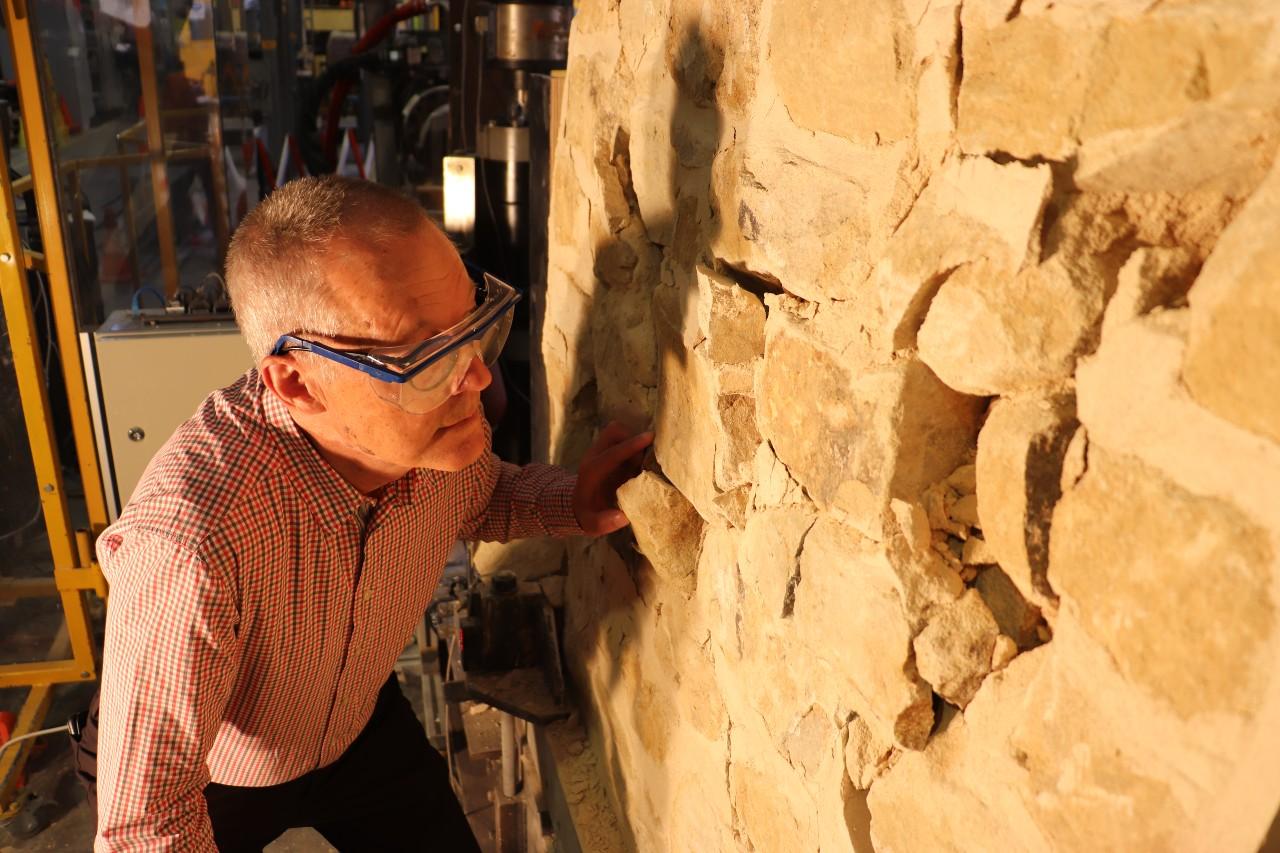Earthquake testing aims to protect Adelaide’s heritage

Professor Michael Griffith examing the wall after an eathquake simulation test
Researchers are simulating the effects of an earthquake on historic buildings in a bid to protect Adelaide’s heritage.
University of Adelaide civil engineers are testing the effects of earthquakes on a specially constructed wall. Data from the tests will be used to decide how to best protect structures from potential damage.
“We want to prevent catastrophic damage to special historic structures such as St Peter’s Cathedral and many similarly important heritage buildings in Adelaide and across the country,” says the University of Adelaide’s Professor Michael Griffith from the School of Civil, Environmental and Mining Engineering.
“The first step in the process is to know how strong the existing structures are so we have built a wall that replicates the kind of masonry that is found in historic buildings.
“We are testing the wall in our lab by putting it under high vertical loads and pushing it horizontally to simulate the movement that would be caused by an earthquake.”
“Data collected will be used by structural engineers and architects when tasked to seismically strengthen heritage structures with designs that are both structurally effective and aesthetically sensitive to the heritage architecture.”Professor Griffith
There is a higher than ten per cent chance that Adelaide will experience a damaging earthquake in the next 50 years. In 1954 an earthquake of magnitude 5.6 with an epicentre 12 km south of Adelaide caused the walls of houses to collapse and resulted in cracking in the city’s main post office.
All of Australia’s heritage-listed unreinforced brick and stone masonry buildings were built long before buildings were designed to resist earthquake forces. Any building constructed since 1995 has been designed so that it will not collapse as a result of an earthquake up to magnitude six. Even so modern buildings may still incur non-structural damage such as cracked walls and ceilings which would require repair.
“To withstand collapse, buildings need to redistribute the forces that travel through them during a seismic event,” says Professor Griffith.
“Data collected will be used by structural engineers and architects when tasked to seismically strengthen heritage structures with designs that are both structurally effective and aesthetically sensitive to the heritage architecture.”
The University team has been assisting structural engineers on how best to strengthen parts of St Peter’s Cathedral so as to make it less susceptible to damage in the event of an earthquake.
“While some of the most important state owned buildings have received some seismic strengthening, many of the others have not,” says Professor Griffith.
“Shear walls, cross braces, diaphragms, and moment-resisting frames are central to reinforcing a building.
“We have inserted a steel frame to strengthen the lantern over the main transept of St Peter’s Cathedral and bracing into parts of the roof, neither of which compromise the aesthetics of the building. We are planning to carry out on-site testing to assess the effectiveness of further proposed measures.”
Over 50 per cent of the buildings in Adelaide’s central business district are unreinforced masonry buildings and many of these are historically significant. Following the major earthquake in New Zealand in 2011, Christchurch’s main cathedral remains in ruins.
“The cost of repairing unprotected historic buildings following an earthquake is prohibitively expensive,” says Professor Griffith.
“We do not want to gamble with our built heritage: properly protecting it now is better than losing it forever.”
This project has been funded by the Australia Research Council.
Media Contacts:
Professor Michael Griffith, School of Civil School of Civil, Environmental and Mining Engineering, The University of Adelaide. Mobile: +61 (0)417 197 225, Email: michael.griffith@adelaide.edu.au
Crispin Savage, Senior Communications and Media Officer, The University of Adelaide. Mobile: +61 (0)481 912 465, Email: crispin.savage@adelaide.edu.au
